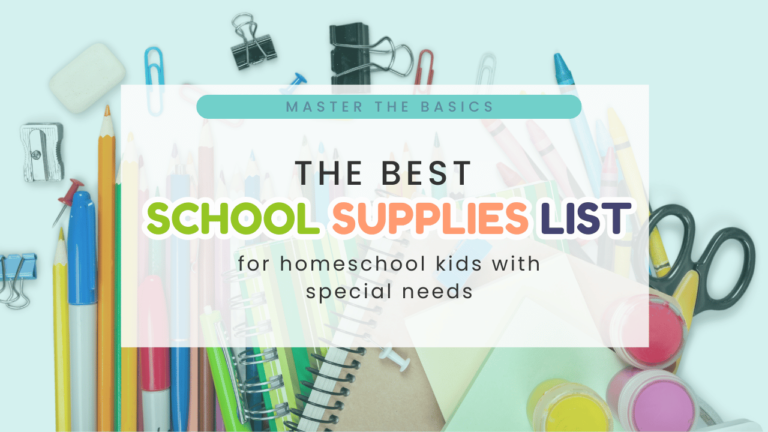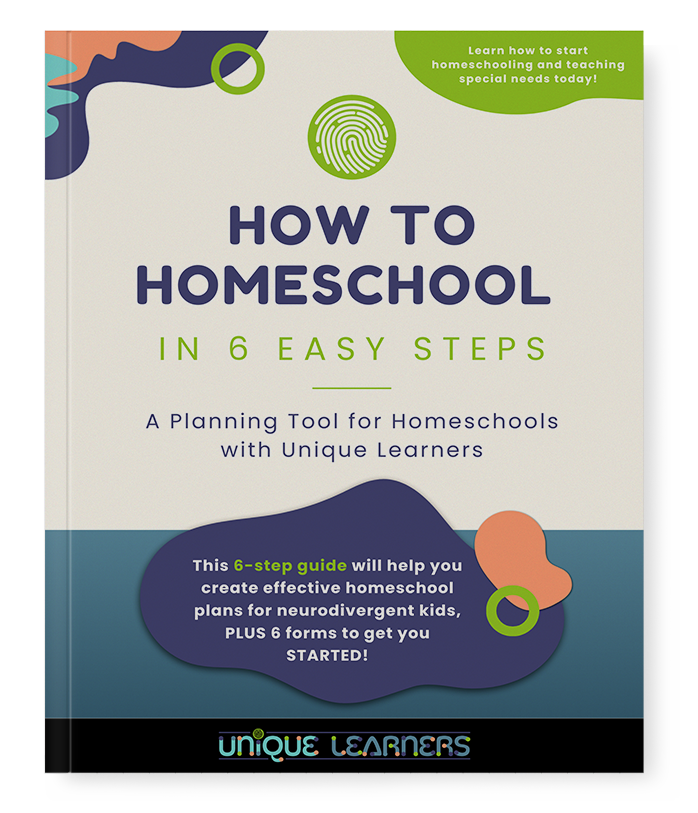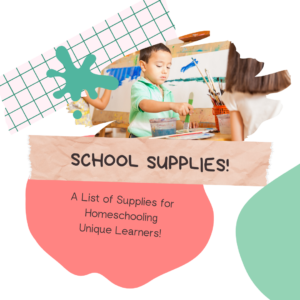
I get so excited about school supplies for our homeschool!
I love when school supplies are arranged on the shelves at the stores during back-to-school season! If you are new to homeschooling, you may be wondering whether you need to buy your kids the same kind of supplies as the plethora of lists that are often found in the kiosks at the store. School supplies can get really expensive, so for those of us living on a tight budget, pulling together a realistic list of homeschool supplies that are actually going to be used may be helpful in saving money.
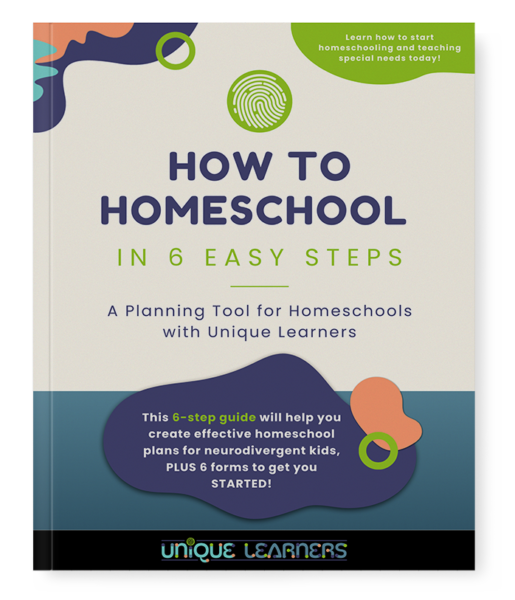
Before we get started with the homeschool supplies list, first grab your FREE e-book “How to Homeschool in 6 Easy Steps” Whether you are new to homeschooling, or need help to revamp your homeschool, this e-book will help you get all the essential forms, legalities, lesson planning, and learning profiles set up for your kid so that you can focus on the more fun and creative aspects of your homeschool. This is exactly what I used in my homeschool every year, so it is tried and true! Click here to grab your free download to get your homeschool set up for SUCCESS!
Planning, Timing, and Stocking Up help to keep the costs down.
Something to keep in mind is that certain school supplies go on deep discount during the back-to-school sales season; while other items seldom go on sale. In my years of homeschooling, I have discovered which items are worth stocking up for the whole year, and which ones I can buy in small quantities and replace as we need them.
I have come up with two homeschool supplies lists that have been helpful in our homeschool. This article is about the Student List, that includes school supplies that my kids have unrestricted access to or any individual supplies that will become their materials to be responsible for. Watch for a second article about my Teacher List of homeschool supplies that I use for my own tasks and keep on hand for throughout the school year to use for group activities and projects.
Make your school supply list tailored to your unique situation.
Each homeschool year is different because kids grow and unit themes or topics of study change. When a child with special needs is part of the homeschool, the school supplies needed may be different than those needed by other homeschool families. I encourage you to take my homeschool supplies list and evaluate whether you may need items in your homeschool. Add any other items you need based on a specific to your situation.
Color-coding school supplies helps stay organized.
Before I start the homeschool supplies lists, I want to share that to keep us organized, save time, and reduce conflicts, I had my kids select a color they wanted to use for their own school things. My kids chose their favorite colors, which also happened to be different from each other. If you have kids who tend to compete with each other or change their minds often, you may want to assign a color-coding system that works for you. The main point is that colors help to make all organization for school consistent and easy to monitor visually.
Once you’ve made your homeschool supplies list, make a copy to insert into your record keeping system.
OK. Here’s my Student List.
- Lined writing paper. This is an item I keep stocked in bulk.
- I use primer lined paper (the one with the middle dotted line) longer than most classroom teachers require before transitioning to wide-lined paper or college-ruled paper. I have some kids use primer paper with narrow lines through the elementary years; although neurotypical learners will typically transition to wide-lined paper sometime in 4th grade.
- I keep a variety of lined paper on hand, but I do not select writing paper based on age. I stock up on whatever seems most appropriate for my children’s fine motor skills and handwriting.
- I also try different specialty handwriting papers, like Channie’s Visual Handwriting Paper, to see if a different format might provide the structure needed to help my kids with touching lines, spacing, or slant.
- For middle school aged students, I buy a color-coded set of spiral notebooks. When we first move to regular notebooks, I buy notebooks in our color-coding system give each kid their color. Usually 2 notebooks in each color are enough for the year.
- As the kids moved into high school, I would get a set of 5 spiral notebooks to teach them how to organize and build study habits. There are even sets in pastel colors!
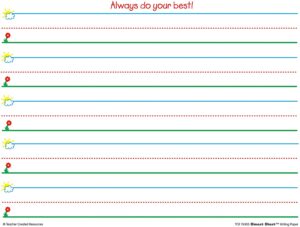
- Pencils. This is a homeschool supplies item I keep stocked in bulk.
- The main pencil I keep on hand is Ticonderoga #2 yellow pencils. I prefer not to offer mechanical pencils until kids are in secondary grades. In the past, I got reward pencils in fun colors for birthdays or seasonal, but I found that most of them have a plastic sleeve that tears in a pencil sharpener (and the kid cries), can be easily peeled (reinforcing OCD behaviors), or even chewed off the pencil (yuck and dangerous)!
- For kids who need help with fine motor skills, I triangle pencils. Ticonderoga has a triangle pencil that is yellow like #2 pencils. PaperMate has a slightly larger mechanical pencil that has a triangular shape.
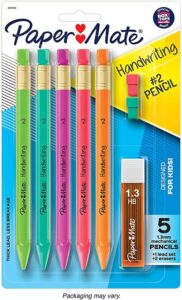
- Some kids need additional help in using one of several pencil holds that will allow for proper bone and muscle growth. There are many different pencil grips that slide right onto a regular pencil. If your child receives OT services, ask your therapist or order a variety set and try them out with your child.
- Colored Construction Paper. This school supplies item seldom goes on sale. Also there is a great difference between the weight of cheap construction paper and heavy construction paper.
- I buy a cheap ream of construction paper in a variety of colors during back-to-school store sales for everyday use throughout the year. If we go through it all, I just replace it any time during the year.
- I order a ream of 9×12 variety pack of heavy weight construction paper for special projects. It’s a bit more expensive, but typically lasts us a couple of years (especially as the kids get older).
- I order a ream of 12×18 variety pack of heavy weight construction paper for projects. This also lasts several years usually.
- My kids and I go through a lot of white drawing paper, so I order a ream of 12×18. I used to order newsprint because it was cheaper, but I found the white sulphite drawing paper is just right for our many drawing projects.
- Crayola Crayons – stock up at BTS.
- When the kids were young, I got each child their own set of 24 crayons. You can save money with other brands, but the cheaper ones tend to have less pigment in the wax. RoseArt is my second choice.
- Crayola Thick Markers– stock up at BTS.
- You will want to decide if the washable form or regular form is best for your family. Washable markers are awesome for cleaning up easily, especially with a magic eraser sponge. Regular markers tend to have slightly more vibrant colors.
- Crayola Thin Markers – stock up at BTS.
- Colored Pencils – stock up at BTS.
- Crayola colored pencils are a good transition tool for kids who still need something softer than a #2 pencil. Colored pencils also drag on the paper more like a regular pencil and they are fun colors. Prismacolor has great artist quality colored pencils in a reasonably-priced set for students
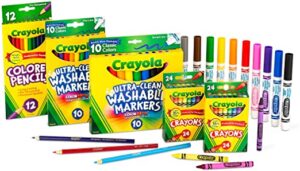
- Sharpies – these homeschool supplies go on sale at BTS and holiday time.
- I get permanent markers only for my older kids who are into drawing practice or need them for making posters or more advanced projects. Until my kids are in high school, I keep permanent markers tucked away to prevent a big accident and a painting project for myself!
- School Glue – stock up at BTS.
- Usually, one or two bottles has been enough to last a school year even if we share. The exception to that is in elementary grades or if you have a kiddo with sensory processing issues. Then I buy clear glue or school glue in a gallon bottle to make slime several times during the year.
- Glue Sticks – stock up at BTS.
- I buy glue sticks in bulk. Lots of them. Usually a pack of 12 for each kid; although I give them each one at a time. I really like the kind that has purple tint that disappears because kids with fine motor issues can see where the glue is going on the paper, so they apply it on more evenly.
- Scissors.
- One pair will last a kid several years. Get a decent brand. Dollar store scissors tend to break.
- If you have an older student who still has significant issues with cutting, be sure to get a scissor that fits the size of their hand rather than their developmental skill level.
- Paints and Paint Brushes – I typically order these school supplies.
- My favorite paint for younger kids is BioColor Paint and Liquid Watercolor Paint by Colorations. I order a set of bottles and they last our family several years. BioColor doesn’t stain as much as tempera paints. Of course, tempera paint is the standard paint for elementary grades. You can get so many different tools to use with them!
- Acrylic paints are harder to clean up, so I do more preventive set up when my kids are old enough to use acrylic paints for their projects.
- Crayola watercolor paints in a plastic case are great to buy at BTS sales. If you plan to use watercolor paints for spelling practice, you may want to pick up one set for each kid.
- If you have early childhood learners, thick nubby brushes are awesome to use when painting on an easel.
- Cheap paint brushes with plastic brushes are very frustrating for anyone. You can get a good set of brushes at a craft store that will last a long time. The trick is to help your children know how to wash out brushes right away.
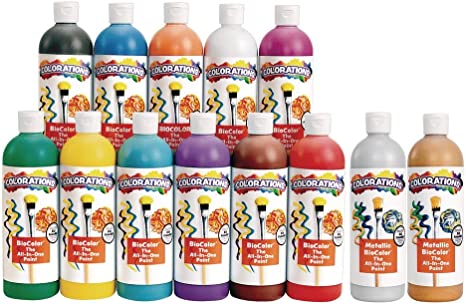
- Shaving Cream.
- This sounds weird, but we go through several cans of shaving cream each year. At least once a month, we have a fun spelling or math day where we clear off the patio table and get mucky with shaving cream! I usually get unscented, but there are varieties with scents and aloe in them, too. Kids LOVE to do shaving cream spelling!
- Play Dough
- Regular PlayDoh brand is easiest; however, there are so many options if your kids have special needs for gluten-free dough, scented dough for sensory issues, home-made dough recipes for making your own in big quantities, kinetic sand, and more! Why dough for older students? Multisensory spelling and math fact practice, of course!
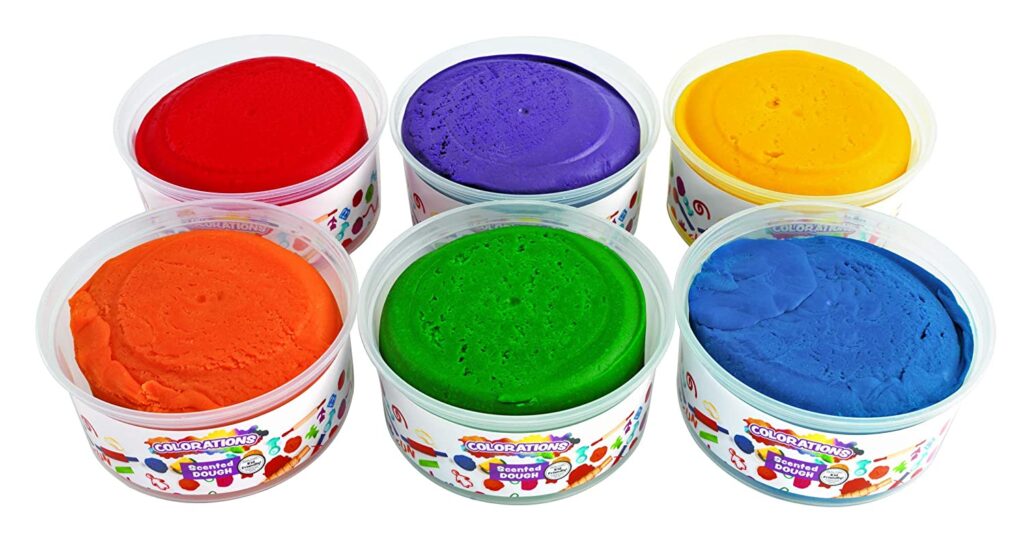
- Dry Erase Boards and Markers – stock up markers at BTS.
- You can get individual dry erase boards at the dollar store or during the BTS sales. They are cheap, but don’t last very long because the laminated surface wears off.
- I typically spend a little more for a medium-sized, magnetic dry erase board. That way, it can still be used in a lap, on the floor, at a table, or hang it on a wall. It is easier to combine magnetic letters and numbers and write on the board at the same time.
- I stick with Expo Markers because they last quite a while and they have less chemical smell. I get a variety of colors in both thick and thin, so we have what we need depending on our purpose. Dry erase markers are cheaper at BTS sale time, so if you plan to use your dry erase boards often, this is a good homeschool supplies item to stock up on.
- Do-a-Dot Markers or Bingo Spotter Paints
- I have both the Do-a-Dot brand and Bingo Spotter bottles that I fill with BioColor Paint because they make different sized circles. We use them quite a bit, and they last quite a while.
- Get them when you need them. They seldom go on sale.
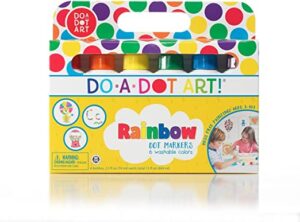
- Folders – stock up at BTS.
- I get these in our color-code system. I have the kids help me label them.
- Some years we use folders a lot, but since we don’t do many worksheets, usually 1 or 2 has been enough for the year.
- Index Cards – stock up at BTS.
- Because I do a lot of multisensory spelling and math fact activities and games, I go through literally hundreds of 3×5 index cards each year. I pick these homeschool supplies up when they are on BTS sales, but I also order them online sometimes when I see a good deal.
- Personal Supply Organizers.
- Decide how you plan to organize your space. Then decide what you want your kids to keep their own supplies in. Mostly they had a plastic pencil box for their own school supplies. Other years, we’ve used dishpan buckets or plastic drawers, and we kept common homeschool supplies in a desktop organizer. One year, they came with me to my store, so they each had a trapper keeper with a long shoulder strap.
- Pencil Box, Zipper Pouch, Trapper Keeper, 3-Ring Binder, etc.
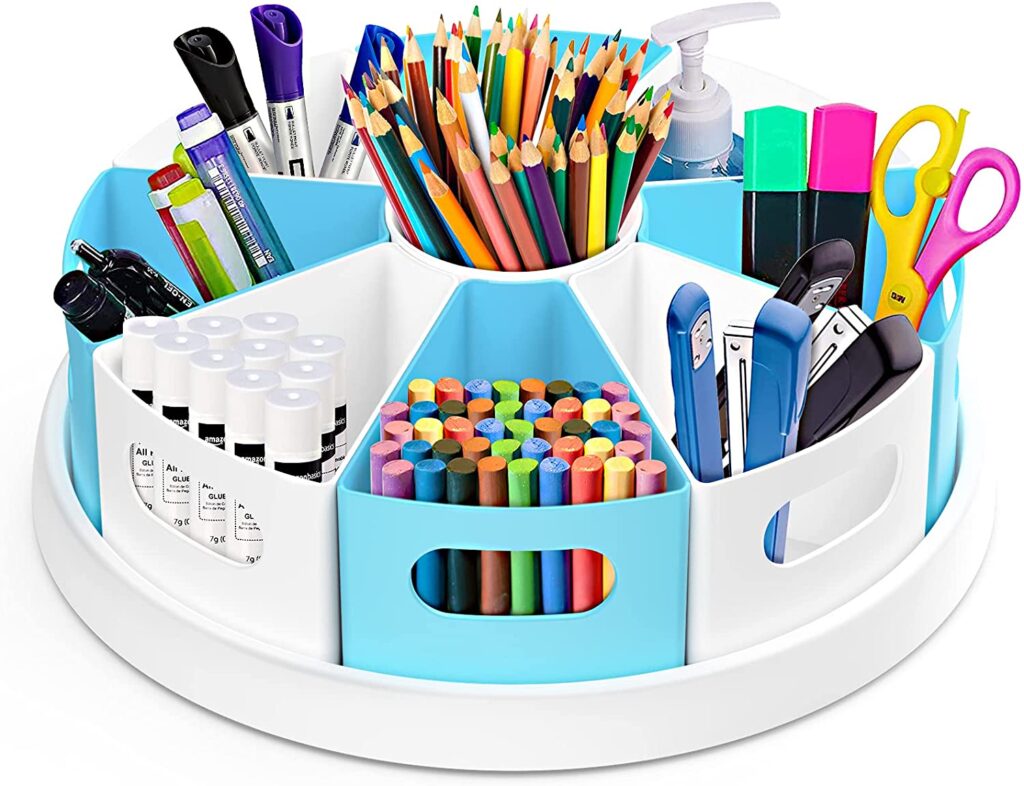
- Art and Craft Homeschool Supplies.
- I get these as we need them for projects, keep a stock of supplies when they go on sale, and keep them in plastic shoebox bins.
- Hot glue guns, wiggly eyes, feathers, tissue paper squares, craft sticks, etc.
I want to close this article by saying that this school supplies list has the items I keep in stock for our homeschool. If your homeschool has different unique learners, you will want to eliminate things that just don’t fit your kids or the way you want to do your homeschool. Add things that are better for your situation that aren’t on the list. Also, this list does not include phonics or math manipulatives, books, or science equipment. Once you know what hands-on learning school supplies go with your curriculum, you will want to get those specific manipulatives.
Remember to watch for the next article on Homeschool Teacher Supplies! I’ll share with you my essentials that make our homeschool run efficiently, take stress off my day, and helps me make learning fun for my kids!
Want to know about new products and blogs?
Are you new to homeschooling, or just wanting a fresh start? Download our FREE “How to Homeschool in 6 Easy Steps” guide and get valuable insights from Sue’s 30+ years of experience as a special educator and homeschool mom of 4!
Also, join our Facebook group!
Join our new “Homeschool Help for Special Needs” Facebook group! It is a place for homeschool moms to ask questions about homeschooling a child with special learning needs, share teaching and curriculum ideas that have worked (and those that bombed), and be real about the unique challenges of homeschooling with special needs. If you want to join us, be sure to answer the member questions to help us keep this private group secure. Join us now!
